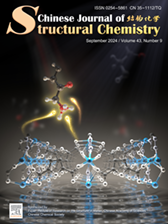
Luminescent coordination polymers with mixed carboxylate and triazole ligands for rapid detection of chloroprene metabolite
Yue Mao, Zhonghang Chen, Tiankai Sun, Wenyue Cui, Peng Cheng, Wei Shi* Submit a Manuscript
Ya-Wen Zhang, Ming-Ming Gan, Li-Ying Sun, Ying-Feng Han*
Chin. J. Struct. Chem., 2024, 43: 100356. DOI: 10.1016/j.cjsc.2024.100356
September 15, 2024
ABSTRACT
In conclusion, we have demonstrated the preparation of TPE-derived imidazo[1,5-α]pyridinium salt H4-L(PF6)4, which was used for accessing dinuclear silver(I) and gold(I) tetracarbene metallacycles [Ag2L](PF6)2 and [Au2L](PF6)2. The initially weakly emissive H4-L(PF6)4 exhibited a remarkable enhancement of fluorescence intensities upon metalation to form the dinuclear silver(I) and gold(I) tetracarbene complexes in dilute solution. Upon the gradual addition of water as a poor solvent to the acetonitrile solution of TPE-derived complexes, the precursor H4-L(PF6)4 exhibited typical AIE characteristics. However, metal complexes [M2L](PF6)2 (M = Ag, Au) showed weak emission in aggregated state. Based on this fact, silver(I) tetracarbene complex [Ag2L](PF6)2 has been employed as a turn-on fluorescent sensor for PA via a self-destructive reaction. This work provides novel insights into the fabrication of stimulus-responsive organometallic materials with potential applications in biological studies.






